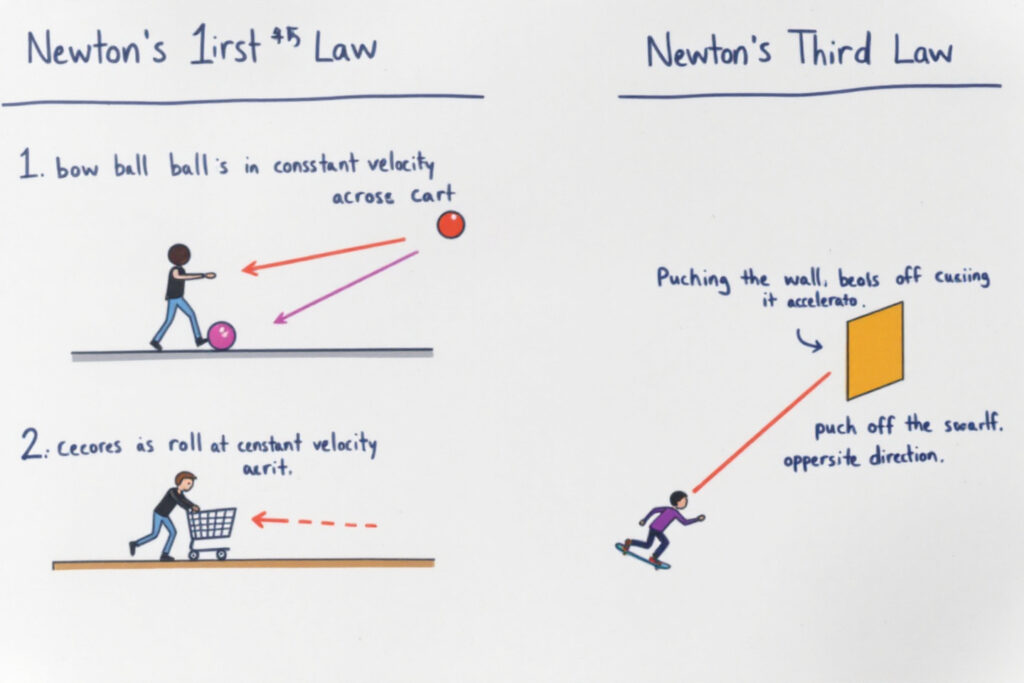Newton’s Laws and Motion Q&A
Comprehensive Q&A on Newton’s Laws, Gravity, and Motion
Q: What is inertia?
Inertia is the property of an object to resist changes in its state of motion. This means that an object at rest will stay at rest, and an object in motion will continue moving at a constant velocity unless acted upon by an external force.
Q: Why does a soccer player pull his hand back while catching a fast-moving ball?
By pulling his hands back, the soccer player increases the time over which the ball’s momentum is brought to zero. This reduces the average force exerted on his hands, making the catch more comfortable and reducing the risk of injury.
Q: Why does an athlete prefer to land on sand instead of a hard floor while taking a high jump?
Sand deforms and compresses upon impact, increasing the time over which the athlete’s momentum is reduced to zero. This reduces the average force exerted on the athlete’s body during landing, making it safer and lessening the likelihood of injury.
Q: Why is it easier to push a shopping cart when it’s empty compared to when it’s full?
According to Newton’s Second Law of Motion (( F = m cdot a )), the force required to accelerate an object is directly proportional to its mass. An empty shopping cart has less mass, requiring less force to push. A full shopping cart has more mass, requiring more force to achieve the same acceleration.
Q: Why does an object moving in a straight line at a constant speed continue to do so unless acted upon by an external force?
This is explained by Newton’s First Law of Motion (the Law of Inertia), which states that an object will remain at rest or in uniform motion in a straight line unless acted upon by an external force. This is due to the object’s inertia, which resists changes in its state of motion.
Q: How does Newton’s Third Law apply to rocket propulsion?
In rocket propulsion, the rocket expels gas out of its engines at high speed (action). According to Newton’s Third Law, the expelled gas exerts an equal and opposite force on the rocket (reaction), propelling it forward.
Q: What is the difference between weight and mass?
Mass is a measure of the amount of matter in an object and is constant regardless of location. Weight is the force exerted on an object due to gravity and depends on both the object’s mass and the local gravitational field. Weight is calculated as ( W = m cdot g ).
Q: What happens to the gravitational force between two objects if the distance between them is doubled?
According to the Universal Law of Gravitation, the gravitational force between two objects is inversely proportional to the square of the distance between them. If the distance is doubled, the gravitational force is reduced to one-fourth of its original value.
Q: What is the significance of the gravitational constant ( G ) in the Universal Law of Gravitation?
The gravitational constant ( G ) is a proportionality factor in the Universal Law of Gravitation. Its value is approximately ( 6.674 times 10^{-11} , text{Nm}^2/text{kg}^2 ). It ensures that the calculated gravitational force is accurate and consistent with observed phenomena.
Q: How does the shell theorem explain the decrease in gravity toward the center of the Earth?
The shell theorem states that a spherically symmetric shell of mass exerts no net gravitational force on an object inside it. As you move toward the center of the Earth, more of the Earth’s mass is above you, canceling out some of the gravitational force. The effective gravitational force decreases linearly with distance from the center.
Q: Why does the gravitational force become negligible at great distances from Earth?
The gravitational force follows the inverse-square law, meaning it decreases rapidly with increasing distance. At great distances, the force becomes very small, approaching zero, making it negligible.
Q: Why does a stationary boat move away when you step ashore?
When you step off the boat, you exert a backward force on the boat (action), and the boat exerts an equal and opposite forward force on you (reaction). This reaction force causes the boat to move away from the shore.
Q: Why do two spring balances joined at their free ends show the same reading when pulled apart?
When two spring balances are joined and pulled apart, they show the same reading because the forces involved are equal in magnitude and opposite in direction, according to Newton’s Third Law. The connection ensures that the force applied to one is transmitted directly to the other.
Q: Why does a light ball rise upwards after striking the ground?
When a light ball strikes the ground, it exerts a downward force on the ground (action). According to Newton’s Third Law, the ground exerts an equal and opposite upward force on the ball (reaction), causing it to rise. Additionally, the ball’s elasticity helps it rebound.
Q: Where is gravity stronger, at the equator or at the polar regions?
Gravity is slightly stronger at the polar regions than at the equator. This is due to the Earth’s shape (an oblate spheroid) and the centrifugal force caused by the Earth’s rotation, which is strongest at the equator and weakest at the poles.
Q: How is the Universal Law of Gravitation connected to the force due to gravity?
The Universal Law of Gravitation, ( F = G frac{M m}{r^2} ), describes the gravitational force between two masses. Near the Earth’s surface, this formula simplifies to ( F = m cdot g ), where ( g ) is the gravitational acceleration, demonstrating how the universal law applies to specific scenarios like the force due to gravity at the Earth’s surface.
Q: Why does gravity decrease as you move higher or toward the center of the Earth?
Gravity decreases with altitude because the distance from the Earth’s center increases, reducing the gravitational pull. It also decreases toward the center of the Earth because the effective mass beneath you decreases, as more of the Earth’s mass is above you, partially canceling out the gravitational force.
Q: What is free fall?
Free fall refers to the motion of an object under the influence of gravitational force only, with no other forces (like air resistance) acting on it. When an object is in free fall, it accelerates downward due to gravity.
Q: What are the equations of motion for free fall from rest?
For an object falling freely from rest (initial velocity ( u = 0 )) under gravity (( a = g )):
( v = g t )
( s = frac{1}{2} g t^2 )
( v^2 = 2 g s )
Q: What are the equations of motion for free fall with initial velocity?
For an object falling with an initial velocity (( u neq 0 )) under gravity (( a = g )):
( v = u + g t )
( s = ut + frac{1}{2} g t^2 )
( v^2 = u^2 + 2 g s )
Q: What is the relationship between weight and mass?
Mass is a measure of the amount of matter in an object and is constant regardless of location. Weight is the force exerted on an object due to gravity and depends on both the object’s mass and the local gravitational field. Weight is calculated as ( W = m cdot g ).



